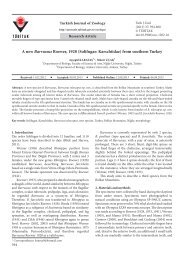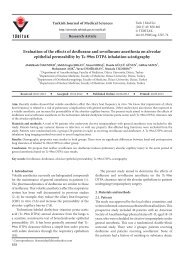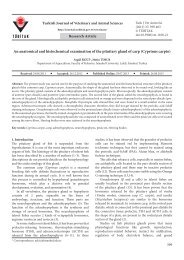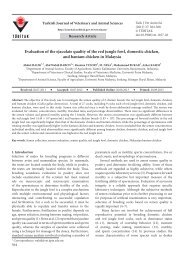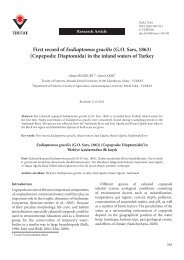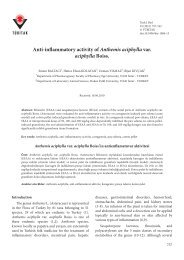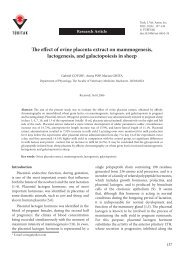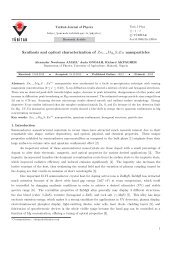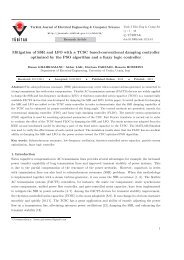Preliminary study on Acropora - Scientific Journals - Tübitak
Preliminary study on Acropora - Scientific Journals - Tübitak
Preliminary study on Acropora - Scientific Journals - Tübitak
You also want an ePaper? Increase the reach of your titles
YUMPU automatically turns print PDFs into web optimized ePapers that Google loves.
descripti<strong>on</strong>s as well as the terminology and measuring<br />
procedures used in this <str<strong>on</strong>g>study</str<strong>on</strong>g> were performed <strong>on</strong> the basis<br />
of the descripti<strong>on</strong>s and the nomenclature suggested by<br />
Wallace (1978), Ver<strong>on</strong> and Wallace (1984), Riegl (1995),<br />
Wallace (1999), Ver<strong>on</strong> (2000), and Wolstenholme et al.<br />
(2003).<br />
In the present paper, a regi<strong>on</strong>al tax<strong>on</strong>omic key <strong>on</strong><br />
the <strong>Acropora</strong> species is also suggested, in which the<br />
characteristics of the specimens found in the present <str<strong>on</strong>g>study</str<strong>on</strong>g><br />
were used for species of the northern and northeastern<br />
parts of the Persian Gulf. For the species of the southern<br />
part, the descripti<strong>on</strong>s given by Wallace (1999) were used.<br />
3. Results<br />
All 1169 specimens were examined, but from those, for<br />
each species a few specimens c<strong>on</strong>taining most of the<br />
plasticity range of the characteristics of that species were<br />
selected for descripti<strong>on</strong> purposes. Throughout this article,<br />
the specimens’ data are presented in the following order:<br />
sampling locati<strong>on</strong>; coordinates of the sampling locati<strong>on</strong>;<br />
locati<strong>on</strong> depth, sampling date, and the museum reference<br />
number. The order followed for the descripti<strong>on</strong> of 2 or<br />
more specimens was also the same.<br />
Whenever branch diameters are provided, they are<br />
presented in the following order: branch diameter at the<br />
base, at the midpoint, and at 5 mm below the tip of the<br />
branch.<br />
From the northern and northeastern parts of the<br />
Persian Gulf, 9 species of <strong>Acropora</strong> were identified during<br />
the <str<strong>on</strong>g>study</str<strong>on</strong>g>. Am<strong>on</strong>gst those species, 6 are reported for the<br />
first time from the area of the <str<strong>on</strong>g>study</str<strong>on</strong>g>, and 2 other species<br />
are new to the Persian Gulf. Although the ecological and<br />
populati<strong>on</strong> data collected during the sampling are not<br />
analyzed in the present paper in general, am<strong>on</strong>gst the<br />
species found in this <str<strong>on</strong>g>study</str<strong>on</strong>g>, A. downingi and A. arabensis<br />
were the most comm<strong>on</strong> species, with A. valida next in<br />
abundance and the rest of the species being rare.<br />
The specimens described in this article are deposited<br />
in the Zoological Museum of the University of Tehran<br />
(ZUTC) and the Nati<strong>on</strong>al Museum of Natural History<br />
(MMTT).<br />
In the descripti<strong>on</strong> of each species, we chose not to<br />
menti<strong>on</strong> the syn<strong>on</strong>yms, as they are available in detail from<br />
Wallace (1999).<br />
<strong>Acropora</strong> valida (Dana, 1846); Figures 2a–2g<br />
Material examined: Iran, Larak Island: 26°53′10.1″N,<br />
56°23′58.3″E; depth 6 m; 7 October 2008; MMTT Cnid.<br />
1024. Larak Island: 26°52′45.8″N, 56°20′26.8″E; depth<br />
6 m; 14 October 2008; MMTT Cnid. 1319. Larak Island:<br />
26°53′12.1″N, 56°23′32.1″E; depth 3 m; 8 October 2008;<br />
ZUTC Cnid. 1115.<br />
Descripti<strong>on</strong>: Branching pattern: Caespitose (usually<br />
for small col<strong>on</strong>ies) to corymbose (usually for large<br />
310<br />
RAHMANI and RAHIMIAN / Turk J Zool<br />
col<strong>on</strong>ies); main branches of large col<strong>on</strong>ies sometimes<br />
grow horiz<strong>on</strong>tally; col<strong>on</strong>y size up to 45 cm (rarely more<br />
than 55 cm) (Figure 2a); branches cylindrical to slightly<br />
tapering (Figure 2b); branch diameters: 6.5–11.9 mm,<br />
7.3–11.7 mm, and 7.2–9.8 mm; branch length up to 29.4<br />
mm; growth determinate or semideterminate depending<br />
<strong>on</strong> the corallum.<br />
Axial corallites: C<strong>on</strong>spicuous, cylindrical, twice the<br />
size of radial corallites; outer diameter 2.0–2.6 mm; calice<br />
diameter and thickness of axial corallites walls similar<br />
(0.8–1.2 mm); round opening; most axial corallites c<strong>on</strong>tain<br />
2 septa cycles; primary septa up to 2/3R, but l<strong>on</strong>ger in the<br />
deeper parts of the calice; sec<strong>on</strong>dary septa up to 1/3R,<br />
sometimes dentate; tertiary septa rarely present (Figure 2f).<br />
Radial corallites: Appressed tubular with oval opening;<br />
more or less equal in size; profile length 2.0–3.3 mm; some<br />
tubular or tubo-nariform corallites (usually having thick<br />
lips) scattered al<strong>on</strong>g branches (Figures 2c and 2d); primary<br />
septa present up to 2/3R; directive septa prominent;<br />
sec<strong>on</strong>dary septa development variable in different<br />
corallites: up to 1/5R in those near the branch base, absent<br />
or partially developed in those near the branch tip.<br />
Coenosteum: Broken-costate to costate <strong>on</strong> outer walls<br />
of radial corallites (Figure 2e); densely arranged lines of<br />
laterally flattened spinules <strong>on</strong> the outer edge of radial<br />
corallite walls; reticulate with simple to slightly elaborated<br />
spinules between radials (Figure 2g).<br />
Color: Pale to cream brown.<br />
Remarks: Comparis<strong>on</strong> of the specimens of A. valida<br />
from this <str<strong>on</strong>g>study</str<strong>on</strong>g> with those described by Wallace (1999)<br />
showed that the branches were relatively thinner and<br />
shorter, and axial corallites were smaller and had thinner<br />
walls in the specimens from the <str<strong>on</strong>g>study</str<strong>on</strong>g> area.<br />
<strong>Acropora</strong> aspera (Dana, 1846); Figures 3a–3g<br />
Material examined: Iran, Farur Island: 26°17′44.1″N,<br />
54°32′22.4″E; depth 6 m; 28 October 2009; MMTT Cnid.<br />
1347. Khark Island: 29°16′33.8″N, 50°18′21.5″E; depth 3<br />
m; 19 December 2009; MMTT Cnid. 1699.<br />
Descripti<strong>on</strong>: Branching pattern: Arborescent (Figure<br />
3a); branch length up to 71.7 mm, tapering slightly towards<br />
the tip, and tapering abruptly at the tip (Figure 3b); branch<br />
diameters: 11.3–13.0 mm, 9.5–10.8 mm, and 6.8–8.4 mm;<br />
growth indeterminate.<br />
Axial corallites: C<strong>on</strong>spicuous; larger than radial<br />
corallites; dome-shaped; outer diameter 2.7–4.0 mm;<br />
calice diameter 1.3–1.6 mm; both primary and sec<strong>on</strong>dary<br />
septa present, primary septa up to 2/3R, sec<strong>on</strong>dary septa<br />
up to 1/2R (Figure 3f).<br />
Radial corallites: Labellate; horiz<strong>on</strong>tal extensi<strong>on</strong> of the<br />
outer walls and absence of inner walls give a gutter-shaped<br />
appearance (Figures 3c and 3d); profile length 1.2–1.7<br />
mm; subimmersed radial corallites scattered between<br />
labellate corallites; crowded; radial corallites in 2 sizes,



